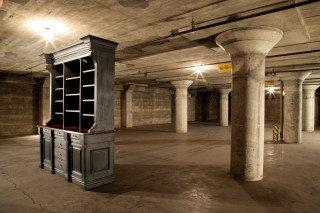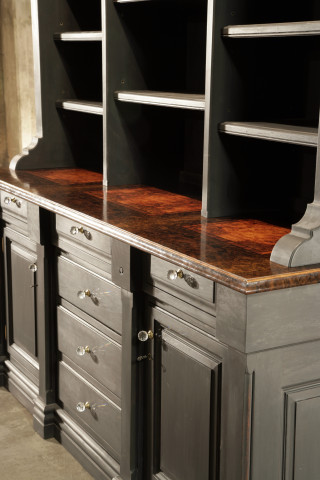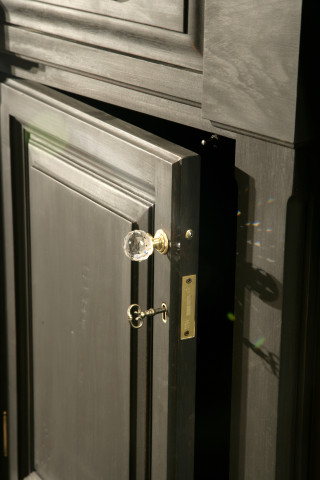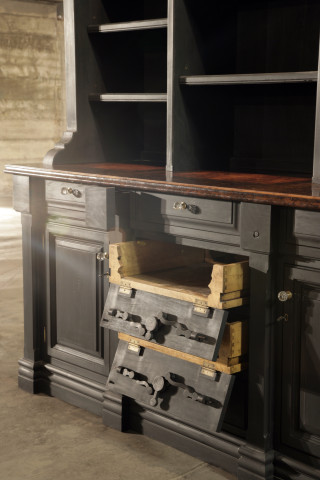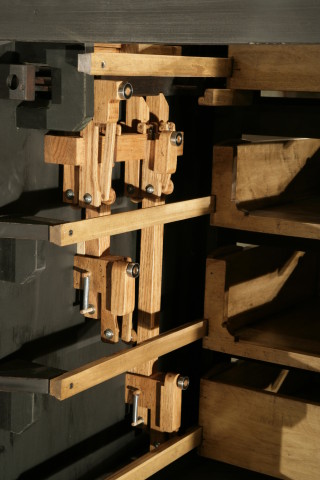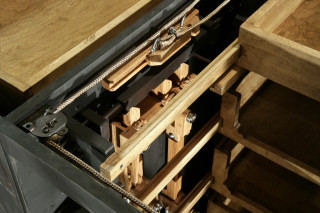Bookcase with Hidden Drawer
The look and feel of the painted bookcase surface replicates that found on antique furniture. Like older traditional finishes, the milk paint used on this bookcase consists of milk protein, clay, earth pigments and lime. Where conventional paint can chip and scratch, milk paint penetrates into the grain; polishing as it wears. For this piece Grabski used three layers of color: lexington green, barn red, and pitch black in that order.
“The subtle complexities will improve as the furniture wears, creating a tortoiseshell appearance.” In addition, Grabski added small tear-outs and other “hand tool marks” to create the authentic look of a genuine antique piece of furniture, along with custom wood drawer slides and full mortise solid brass hardware. To create the rich tones on the walnut and Carpathian elm burl book matched veneer top he used Kusmi #1 button shellac imported directly from India. The shellac is applied over a preliminary coat of boiled linseed oil.
“The oil penetrates the wood giving a maximum illumination to the fibers.” Because there’s no purity standard for ethanol labeled “Denatured Alcohol” for dissolving the shellac, Grabski uses high-test, 190 proof Everclear (95% pure ethanol) as his preferred shellac solvent. “No other finish can compare when it comes to the illumination of the natural beauty inherent in the wood.” “It’s not only what’s visible that makes this piece unique, but rather what goes unseen,” Grabski adds.
Built into the bookcase is a hidden drawer. To access the drawer, you have to pull each of the visible drawers open to a certain point before the latches they control slide out of the way, similar to how the pins in a regular lock work. That allows a length of wooden dowel to slide out – hidden as a knot in the wood itself – to trigger the opening of the secret compartment built into what looks like a normal molding.
Buy the Plans for the Hidden Drawer
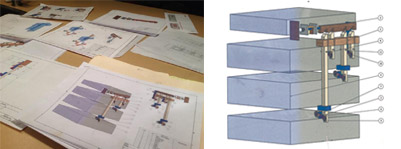
If you’re here, you’ve probably seen my YouTube videos on the hidden drawer mechanism incorporated in my featured project bookcase. Now, take a look behind the scenes at the drawings and sketches used to create this project. Includes:
- Preliminary shop sketches of the drawer locking mechanism
- CAD drawings in PDF format
- Specifications and Dimensions for Components
Price: $8.99
Files available for download immediately after you purchase.
How the Hidden Mechanical Locking Mechanism Works
The hand-crafted custom bookcase requires you pull open each of the visible drawers, before a hidden control springs out and allows you to trigger the secret compartment built into what looks like a normal molding.
To make things more complex, each of the drawers must be pulled out to a certain point before the latches they control slide out of the way, similar to how the pins in a regular lock work. That finally allows a length of wooden dowel to slide out – hidden, normally, as a knot in the wood itself – and when you twist it and then push it back in, a cable tracked around the back of the cabinet allows the hidden drawer to spring out.

